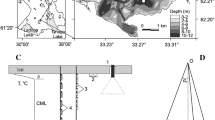Abstract
In this study, a highly idealized model is developed to discuss the interplay of diurnal heating/cooling induced buoyancy and wind stress on thermally driven flow over a vegetated slope. Since the model is linear, the horizontal velocity can be broken into buoyancy-driven and surface wind-driven parts. Due to the presence of rooted vegetation, the circulation strength even under the surface wind condition is still significantly reduced, and the transient (adjustment) stage for the initial conditions is shorter than that without vegetation because of the reduced inertia. The flow in shallows is dominated by a viscosity/buoyancy balance as the case without wind, while the effect of wind stress is limited to the upper layer in deep water. In the lower layer of deep regions, vegetative drag is prevailing except the near bottom regions where viscosity dominates. Under the unidirectional wind condition, a critical dimensionless shear stress \(\Gamma _{cri} \) to stop the induced flow can be found and is a function of the horizontal location \(x\). For the periodic wind condition, if the two forcing mechanisms work in concert (\(\theta =0\)), the circulation magnitude can be increased. For the case where buoyancy and wind shear stress act against each other (\(\theta =\frac{1}{2}\)), the circulation strength is reduced and its structure becomes more complex. However, the flow magnitudes near the bottom for \(\theta =0\) and \(\theta =\frac{1}{2}\) are comparable because surface wind almost has no influence.









Similar content being viewed by others
References
Monismith SB, Imberger J, Morison ML (1990) Convective motion in the sidearm of a small reservoir. Limnol Oceanogr 35:1676–1702
Lövstedt C, Bengtsson L (2008) Density-driven current between reed belts and open water in a shallow lake. Water Resour Res 44(10):W10413
Coates MJ, Patterson JC (1993) Unsteady natural convection in a cavity with non-uniform absorption of radiation. J Fluid Mech 256:133–161
Rattray MJ, Hassen DV (1962) A similarity solution for circulation in an estuary. J Marine Res 20:121–133
Carpenter SR, Benson BJ, Biggs R, Chipman JW, Foley JA, Golding SA, Hammer RB, Hanson PC, Johnson PTJ, Kamarainen AM, Kratz TK, Lathrop RC, McMahon KD, Provencher B, Rusak JA, Solomon CT, Stanley EH, Turner MG, Wu CH, Yuan H (2007) Understanding regional change: comparison of two lake districts. BioScience 57(4):323–335
James WF, Barko JW (1991) Estimation of phosphorous exchange between littoral and pelagic zones during nighttime convection circulation. Limnol Oceanogr 36(1):179–187
Farrow DE, Patterson JC (1993) On the response of a reservoir sidearm to diurnal heating and cooling. J Fluid Mech 246:143–161
Chimney MJ, Wenkert L, Pietro KC (2006) Patterns of vertical stratification in a subtropical constructed wetland in south Florida (USA). Ecol Eng 27:322–330
Adams EE, Wells SA (1984) Field measurements on side arms of Lake Anna, VA. J Hydraul Eng ASCE 110:773–793
Farrow DE (2004) Periodically forced natural convection over slowly varying topography. J Fluid Mech 508:1–21
Farrow DE, Patterson JC (1994) The daytime circulation and temperature pattern in a reservoir sidearm. Int J Heat Mass Transf 37:1957–1968
Lei C, Patterson JC (2002) Unsteady natural convection in a triangular enclosure induced by absorption of radiation. J Fluid Mech 460:181–209
Drazin PG, Reid WH (2004) Hydrodynamic stability, 2nd edn. Combridge University Press, Combridge
Lei C, Patterson JC (2006) Natural convection induced by diurnal heating and cooling in a reservoir with slowly varying topography. JSME Int J Ser B 49:605–615
Bednarz TP, Lei C, Patterson JC (2009) Unsteady natural convection induced by diurnal temperature changes in a reservoir with slowly varying bottom topography. Int J Therm Sci 48:1932–1942
Tanino Y, Nepf HM, Kulis PS (2005) Gravity current in aquatic canopies. Water Resour Res 41(12):W12402
Zhang X, Nepf HM (2008) Density driven exchange flow between open water and an aquatic canopy. Water Resour Res 44(8):W08417
Nepf HM, Oldham CE (1997) Exchange dynamics of a shallow contaminated wetland. Aquat Sci 59:193–213
Zhang X, Nepf HM (2009) Thermally driven exchange flow between open water and an aquatic canopy. J Fluid Mech 632:227–243
Oldham CE, Sturman JJ (2001) The effect of emergent vegetation on convective flushing in shallow wetlands: scaling and experiment. Limnol Oceanogr 46(6):1486–1493
Zhang X, Nepf HM (2011) Exchange flow between open water and floating vegetation. Environ Fluid Mech 11(5):531–546
Lin YT, Wu CH (2014) The role of rooted emergent vegetation on periodically thermal-driven flow over a sloping bottom. Environ Fluid Mech. 10.1007/s10652-014-9336-5
Simpson J (2007) Sea breeze and local winds. Cambridge University Press, Cambridge
Farrow DE (2013) Periodically driven circulation near the shore of a lake. Environ Fluid Mech 13(3):243–255
Böckh P, Wetzel T (2011) Heat transfer: basics and practice. Springer, Berlin
Jamali M, Zhang X, Nepf HM (2008) Exchange flow between a canopy and open water. J Fluid Mech 611:237–254
Poulikakos D, Bejan A (1983) The fluid dynamics of an attic space. J Fluid Mech 131:251–269
Brown J, Churchill R (2009) Complex variables and applications. McGraw-Hill, New York
Farrow DE (1991) Unsteady natural convection in reservoir sidearms. Dissertation, University of Western Australia
Wu J (1982) Wind-stress coefficients over sea surface from breeze to hurricane. J Geophys Res 87(12):9704–9706
Acknowledgments
The author would like to thank funding support from the National Chiao-Tung University of Taiwan and National Science Council of Taiwan through grants NSC 102-2218-E-009-005.
Author information
Authors and Affiliations
Corresponding author
Rights and permissions
About this article
Cite this article
Lin, YT. Wind effect on diurnal thermally driven flow in vegetated nearshore of a lake. Environ Fluid Mech 15, 161–178 (2015). https://doi.org/10.1007/s10652-014-9368-x
Received:
Accepted:
Published:
Issue Date:
DOI: https://doi.org/10.1007/s10652-014-9368-x




